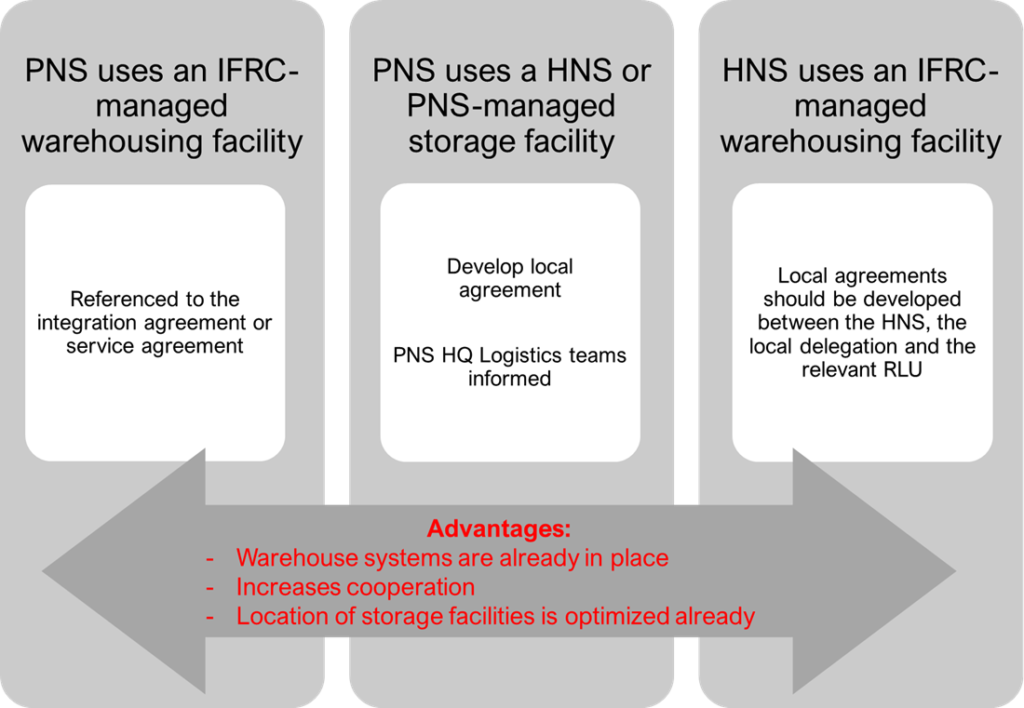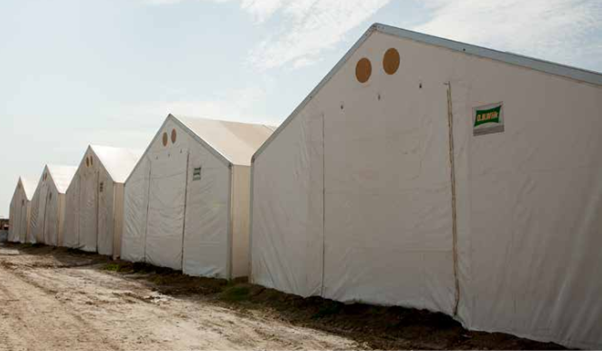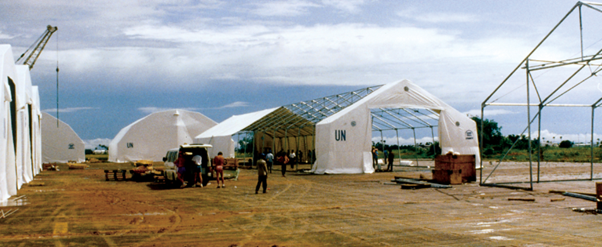How Can We Help?
Sourcing a warehouse
Setup options
Central, regional and distribution-point warehouses can be built, commercially rented or provided by the host National Society, the government or operational partners. Buildings designed for storage are preferred as central or regional warehouses.
Where no suitable facilities exist, the construction of temporary or permanent warehouses should be considered. Immediate and interim needs can be met through the use of specially designed warehouse tents (Mobile Storage Units, MSUs) or other temporary storage facilities.
Wherever possible, avoid sharing a warehouse with another agency and, especially, commercial firms. Where this is unavoidable, fence off different partners’ areas or clearly mark each partner’s stock. Additionally, when sharing a warehouse with another agency, a standard Memorandum of Understanding (MoU) should be signed to specify the detailed terms and conditions of the lease/sharing.
Options to share warehouse facilities within :

Available to download here.
Types of warehouse
Temporary warehouses
Tents and Mobile Storage Units
Tents can be standard tents or Rubb Hall (MSU) tents.
Tents should always be set up on flat and firm ground (preferably on a concrete slab), with ditches around their outside perimeter. If possible, add a tarpaulin or net on top of the tent, allowing space for ventilation between the roof of the tent and the additional tarpaulin. If using a tarpaulin to cover stored items, ensure that a separate tarpaulin protects the items from the ground. Make sure the tent can be securely closed with padlocks. Ideally, it should be fenced inside and out to limit access and manned with 24-hour security wherever possible.
Rubb Halls (also known as mobile storage units or MSUs) are tents that have been specially developed for emergency storage purposes. The standard model used in operations offers a maximum 600m3 of storage, and a ground surface of 240m2 for palletised storage.

Erecting a tent requires 12 people, at least one of whom must be a trained technician, and takes two days. Rubb Halls should also be lined with mesh or chicken wire to prevent theft.
Rubb Halls are usually equipped with a locking system that requires one large padlock, or two padlocks if the Rubb Hall can be opened at both ends.
- length: 24m
- width: 10m
- height: from 3m on side to 6m at ridge approx.
- materials: steel structure and UV proof PVC coated canvas cover
- logo/branding: banners that can be attached or printed directly on the canvas.
Note: Rubb Halls are available in different sizes. However, the above is as per RCRC standards and is the model deployed to most RCRC operations.
Rubb Halls can be ordered by logistics through the or the or directly from the supplier. The British Red Cross holds Rubb Hall tents in the IFRC in Panama, Kuala Lumpur and Dubai. Rubb Halls are only to be released for extremely urgent and rapidly onset operations, with a strong business case and approval of the relevant international logistics coordinator.
Good reasons to deploy a Rubb Hall include:
- Where there is extensive damage to buildings.
- Temporary increase of stock in emergency situations (where warehousing space is already available but insufficient to absorb increased stock).
- Pre-positioning of stock in remote locations where there is no infrastructure.
- Legal response where humanitarian agencies are not allowed to build permanent structures.
- A high likelihood that the location of the operation will change in the duration of the response.

Re-purposed containers/wagons or barges
Where no firm ground can be found or where tents cannot provide security for stock, it is possible to use shipping containers as temporary storage. If a container is used for long-term storage, it needs to be repurposed to create optimal conditions for its maintenance and for the items stored.
Detailed instructions on how to re-purpose containers, wagons or barges can be found here.
Permanent warehouse
In emergency setups, warehousing facilities will usually be rented as opposed to purchased.
Find a suitable warehouse
Characteristics of a good warehouse:
- solid building with a firm, flat floor
- dry and well ventilated
- gives protection against animals, insects and birds.
- gives protection against humidity, extreme temperature fluctuations and local weather conditions
- easy access for trucks
- easy loading and unloading
- secure against theft (locked, gated, etc.)
- in an appropriate site – low disaster vulnerability, above flood level, away from salt spray…).
Also consider:
- size of the warehouse
- 24/7 accessibility
- Red Cross visibility
- ownership of the warehouse or the land it is on
- avoid sharing with other agencies. If this is impossible, clearly mark your area.
Agree lease conditions
- cost and payment schedule
- period of lease agreement
- period of notice for terminating or extending the lease
- include confirmation of property insurance, covering third party, fire, water damage and any damage to the structure of the building
- details of security arrangement: who will provide security services and in what pattern (number of guards, rotation times, validation of guards, etc)
- an inventory of any equipment, fixtures and fittings included with the building and a detailed description of their condition and maintenance requirements
- confirmation of sole tenancy or, where relevant, details of other tenants
- For warehousing facility – the memorandum of understanding with sharing tenants should be annexed to the lease contract
- information about the ground or floor strength
- weight capacity of any equipment included in the lease (forklift, racks shelves, etc).
- access by the landlord to the warehouse specified in the lease. The landlord should preferably notify the leasing party before accessing the warehouse.
To uphold the ’s neutrality principle, the identity of the owner of the premises (might be different from the leaser) must be known. Where the owner is linked to the military, religious authorities or government, this should be reported to headquarters for risk analysis.
Also review any previous usages of the warehouse to identify risks, such as if it was previously used to store dangerous or toxic material, weapons, etc.
A template Warehouse rental contract template is available to download here and at the end of this section.
Read the next section on Setting up a warehouse here.
Related resources
Download useful tools and templates

